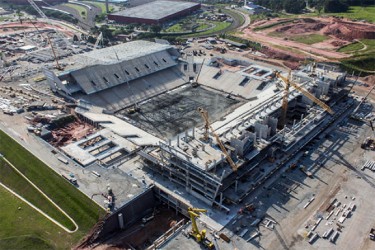SAO PAULO, (Reuters) – When Brazil first won the right to host the 2014 soccer World Cup, officials knew they would need a modern stadium with more than 65,000 seats in the country’s biggest city.

As it happened, Sao Paulo had just such an arena: Cicero Pompeu de Toledo Stadium, known as “Morumbi,” standing amid a sea of orange-roofed mansions on the western side of the city.
But after nearly three years of negotiations and delays, World Cup organizers instead opted to build a brand-new stadium on the poorer eastern edge of town – a decision that involved a popular former president, one of Brazil’s most bitter soccer rivalries, and no small degree of controversy.
Scrutiny of that decision has intensified following a fatal accident on Nov. 27 at the building site of the new stadium, called Arena Corinthians. A crane collapsed while lifting a 420-tonne piece of roof into place, crushing a portion of the facility’s exterior and killing two workers on the ground below.
The accident has pushed back the stadium’s estimated completion date from December to April, according to FIFA, the governing body of world soccer. That is perilously close to the June 12 date for the World Cup’s opening match, between Brazil and Croatia, which Arena Corinthians is due to host.
Officials are still probing the causes of the crane collapse, and there is no evidence that the company building the stadium, Odebrecht SA, committed any wrongdoing. Odebrecht said in a statement that construction “has followed rigorous planning and respected the appropriate speed.”
The stadium’s supporters say the 68,000-seat facility will help support economic development in a depressed area of mostly one-story houses some 12 miles (20 km) east of downtown.
“This area has been ignored for years, but this stadium will be a source of pride and much more,” Andres Sanchez, a former president of the Corinthians soccer club, said in an interview earlier this year. Corinthians will own the arena when it is completed.
To some critics, the recent accident is particularly galling because they say the stadium should never have been built in the first place. They say its troubled history is emblematic of the poor planning, murky negotiations and wasteful spending that have become big political issues here as the Cup draws closer.
Public outrage over the roughly $3.5 billion being spent to build or renovate Brazil’s 12 World Cup stadiums – including nearly $500 million at Arena Corinthians alone – was a major reason why more than a million Brazilians took to the streets in anti-government protests in June.
President Dilma Rousseff’s approval rating plummeted during the demonstrations, though it has partly recovered as she prepares to run for reelection next October. Many political analysts and other Brazilians believe that protests will erupt again next year when the World Cup starts, especially if preparations are plagued by further tragedy and mismanagement.
“I think the more people find out about (Arena Corinthians), the angrier they’ll get,” said Paulo Resende, a logistics expert at Fundação Dom Cabral, a leading business school.
RENOVATIONS WERE NEEDED
There was no hint of such a controversy back in 2007 when FIFA granted Brazil – the only country to win the World Cup five times – the right to host the tournament in 2014.
Indeed, Morumbi was a near-consensus choice to host games in Sao Paulo. The stadium was built in the 1950s, but it underwent extensive renovations in the 1990s and remains the city’s venue of choice for big soccer games and concerts, including Madonna and Lady Gaga last year.
The government also planned to finish a new subway link to Morumbi in time for the World Cup.
Morumbi lacked certain standards that FIFA demands for the Cup, such as extra parking and better visibility for fans. Hosting the opening match also brings special needs, such as a media center and space to accommodate visiting heads of state.
So the soccer team that owns the stadium, Sao Paulo Futebol Clube (SPFC), offered several plans for renovations, costing between $130 million and $330 million depending on their scope.
Talks over renovations continued until June 2010, when FIFA declared that Morumbi would be “excluded” from the Cup.




